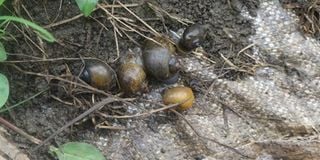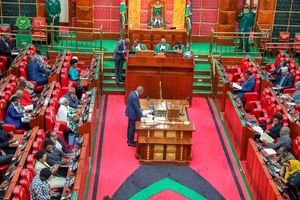Invasive snail wreaking havoc on Mwea rice farms spreads to more countries

Apple snail was confirmed present in Kenya by the Centre for Agriculture and Bioscience International (CABI) in the Mwea Irrigation settlement scheme in Kirinyaga County in 2020.
What you need to know:
- The snail, notorious for its ability to slash yields by half, feeds voraciously on young rice seedlings, leaving farmers in distress and economies vulnerable to substantial losses.
Uganda, Tanzania, Ethiopia, Malawi, Madagascar and Mozambique have been put on red alert over the invasion of a destructive water snail that has already infested over 80 per cent of Kenya's largest rice-producing region - Mwea irrigation scheme.
The apple snail scientifically known as Pomacea canaliculata (P. canaliculata) now threatens rice farmers across Africa.
Recent research led by Centre for Agriculture and Bioscience International (CABI) in collaboration with the Kenya Plant Health Inspectorate Service (KEPHIS) warns that this invasive species, first reported in Kenya in 2020, is rapidly becoming a menace to rice cultivation, a crucial crop for both food security and income generation in the region.
The study paints a worrying picture of the pest’s possible invasion routes in Kenya, with regions along Tana River, Western Kenya and coastal areas deemed highly suitable for its spread.
If swift action is not taken, farmers in these newly identified risk zones in Africa could face the same challenges that their Kenyan counterparts are battling today.
“Across the region, suitability for P. canaliculata was broadly high across Malawi, Madagascar and Uganda. Mozambique, Tanzania and Ethiopia also had areas of high suitability, but these were more concentrated in specific areas of these countries. Conversely, Sudan, South Sudan, Eritrea, Djibouti and Somalia were largely unsuitable for P. canaliculata invasion, although the areas along the Nile in Sudan were moderately suitable,” says the study released on October 2 by CABI.
Madagascar is one of Africa’s largest rice producers, with rice playing a vital role in the country's agriculture, economy, and food security, yet it continues to struggle with achieving self-sufficiency. The invasion by the snail further jeopardises rice paddies, posing a significant risk to production.
Tanzania and Malawi are key rice producers in Africa, with Mozambique standing out as one of the largest producers in southern Africa, where rice is essential for both domestic consumption and export. At the same time, Ethiopia and Uganda have seen substantial growth in rice production in recent years, establishing themselves as significant players in their agricultural sectors and enhancing food security, despite not being traditional rice producers.
“The snail is among the world’s worst invasive species and its impacts have been documented in various parts of the world. Knowledge of the boundary of invasion is important in appropriate resource allocation in the surveillance and management of the pest,” said Fernadis Makale, lead researcher of the study.
“Given the potential for further spread, strict quarantine measures are essential to prevent the spread of P. canaliculata in Kenya and its introduction to uninvaded regions of Eastern Africa. Alongside this, implementing integrated pest management strategies is crucial for effective pest management and the protection of agricultural ecosystems,” added the study.
The apple snail is a prolific invasive species that invades freshwater systems and is listed among 100 of the worst invasive alien species in the world. Native to South America, it has spread widely and is now considered a serious global pest causing significant economic and ecological impacts.
However, the pathway of introduction of this snail in Kenya remains unknown although unconfirmed media reports suggest that it was introduced for research and weed biocontrol purposes. No authorised organisation in the country has issued import permits for the species.
For rice farmers especially, the stakes couldn’t be higher.
Rice fields in Mwea, once a symbol of prosperity, are now battlegrounds as local farmers struggle to protect their crops from the devastating impact of the snail. The snail, notorious for its ability to slash yields by half, feeds voraciously on young rice seedlings, leaving farmers in distress and economies vulnerable to substantial losses.
“A recent study in Kenya to assess the socio-economic impacts associated with the arrival of P. canaliculata reported significant reductions in rice yield (14 per cent) and net rice income (60 per cent) at a moderate infestation level of 20 per cent of cultivated area,” said the report.
The pest can reduce yields by as much as 50 per cent, with economic impacts running into millions of US dollars.
Furthermore, the detrimental effects extend beyond crop-related concerns and encompass impacts on human health (as vectors for parasites such as rat lungworm parasite, which can cause potentially fatal eosinophilic meningitis in humans and animals and natural ecosystems.
The snail’s invasiveness is driven by its ability to tolerate a wide range of habitats and adapt to harsh conditions, such as agrochemical use and intermittent drainage. Its high reproductive rate and genetic diversity lead to rapid population growth, while its competitive edge over native species and lack of natural predators further boost its spread. The snail’s ability to breathe air and aestivate in dry conditions enhances its survival, especially in rice fields. As a result, invaded areas face severe crop damage, replanting costs, and increased management expenses, making it a formidable pest to control.
Now, with the potential for the pest to spread across borders, the alarm is sounding louder than ever.
Rice is the third most important crop in Kenya, grown primarily under irrigation. For farmers in areas like Mwea, rice not only feeds their families but also drives their incomes. Yet, this livelihood is under siege.
In Kenya, the management of this pest has predominantly relied on physical and cultural practices, with some farmers resorting to the desperate use of unregistered and potentially illegal broad-spectrum synthetic chemicals. Other strategies employed by farmers include hand-picking adults, crushing egg masses and implementing water-flood management techniques such as alternate wetting and drying. Unfortunately, most of these practices have proven ineffective in containing the spread of P. canaliculata. Compounding the issue is the absence of registered pesticides specifically formulated for controlling P. canaliculata in the country.
Mr Makale added: “Unfortunately, most of these management practices have proven to be either cumbersome, impractical, expensive or ineffective. Key to the management of the apple snail is early warning and contingency planning.”
“Furthermore, strict quarantine measures should be developed and planting material and machinery from Mwea must be thoroughly inspected and disinfected before being allowed into other schemes,” said Mr Makale.
Though some countries in the region, including Sudan, South Sudan, and Somalia have been deemed to be at low risk, the danger looms large for Kenya and its neighbouring nations. The snail, known for devastating rice crops by feeding on young seedlings, can reduce yields by up to 50 percent. This could mean a loss of millions of dollars, hitting farmers’ pockets hard and threatening national food security.





